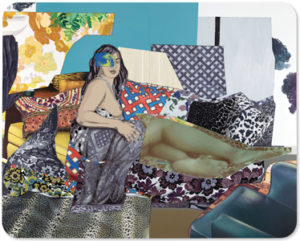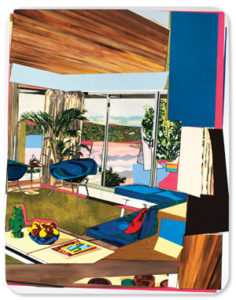
Mickalene Thomas Boldly Claims Her Space
‘Superstar lesbian artist’ comes to Rice’s Moody Center for the Arts.
By Andrew Edmonson
Mickalene Thomas is riding the crest of the wave of a dazzling career. Over the last five years, the 46-year-old artist has had a slew of highly lauded solo exhibitions in museums and galleries across the country, from the Brooklyn Museum in New York City to the Museum of Contemporary Art, Los Angeles.
Her work is collected by such blue-chip institutions as the Museum of Modern Art, the Art Institute of Chicago, the Solomon R. Guggenheim Museum, and the Whitney Museum of American Art.
She was commissioned to create the cover of Solange Knowles’ limited-edition EP, True. And she directed the HBO documentary Happy Birthday to a Beautiful Woman that chronicled the life of her mother and muse, Sandra Bush, a 1970s fashion model.
The Advocate has dubbed Thomas “the superstar lesbian artist.”

At the end of September, she will make her first trip to the Lone Star State for the opening of the exhibition Mickalene Thomas: Waiting on a Prime-Time Star at the Moody Center for the Arts, Rice University’s stunning new $30 million, 50,000-square-foot art space. The exhibition, on view from September 28 through January 13, will feature paintings, photographs, collages, prints, and mixed-media works that explore the artist’s complex vision of female sexuality, identity, and power.
“Her work operates artistically at the highest level while inviting conversation about some of the most important issues facing our country today,” says Alison Weaver, executive director of the Moody Center.
“Her work is extraordinary for its sustained focus on the African-American
female experience and its deep exploration of the history of art,” Weaver adds. “Through her paintings, photographs, and collages, Thomas activates the most traditional artistic genres—portraiture and landscape—with a fresh new perspective.”
Weaver says Thomas samples freely from art history, looking closely at works by Romare Bearden, Manet, Monet, and Matisse, while staying rooted in the contemporary cultural moment. “The resulting artworks are images that you can’t stop looking at or thinking about,” Weaver says.
Thomas told The Advocate in February that she hopes someone standing in front of her art will feel “a sense of possibility and accessibility.”
“Just as my muses insist on their visibility and identity, I want my viewers to feel present with fierceness and boldness,” she said. “It’s our right to claim this space.”
Born in Camden, New Jersey, in 1971, Thomas was raised as a Buddhist by a mother who struggled with substance abuse and turbulent relationships. She and her brother were exposed to art when their mother enrolled them in after-school programs at the Newark Museum and the Henry Street Settlement in New York City.
When Thomas came out as a lesbian in her 20s, her mother was supportive. She went on to receive a bachelor’s degree from the Pratt Institute and a master’s degree in fine arts from the Yale University School of Art. “I wasn’t seeing images of women that I could relate to that were deemed iconic images of art history. I wanted to see myself,” Thomas said.

Interior: Blue Couch with Green Owl, 2012
© Mickalene Thomas
“In order to do that, I started to look at my own environment, and work with women that were in my life,” she added. “[I started] using myself as a vehicle to place the black body in these hierarchical positions by re-contextualizing and formatting them [as reclining nudes]—in the same positions [used by] some of these painters we deem as champions, as groundbreaking revolutionaries.”
Houston had its first tantalizing glimpse of Thomas’ work in 2016, when her large-scale 2007 photograph “Lovely Six Foota” was featured in the Museum of Fine Arts exhibition Statements: African American Art from the Museum’s Collection. It was a highly theatrical, staged depiction of a sensual African-American woman, trailing Black Power glory in chic 1970s regalia with her legs spread slightly, looking boldly and directly at the viewer. The museum acquired the work for its permanent collection.
“All of the women in my work have a profound sense of confidence, and recognize themselves as the visible subject,” Thomas has said. “Their directness is filled with agency and self-knowledge. They have all the power and control to demand [that] the viewer meets them in their own space, rather than being exploited or scrutinized.”
The title of Thomas’ exhibition at the Moody Center refers to a 1977 painting by the late African-American painter Robert Colescott, “Colored TV (Wishing on a Prime-Time Star).”
“Mickalene’s 2015 work, ‘I’ve Been Good to Me,’ which is in the exhibition, references Colescott’s earlier image,” Weaver says. “The shared wordplay draws from the politicized racial and sexual motifs recurring in both artists’ works.”
Mickalene Thomas: Waiting on a Prime-Time Star is free and open to the public at The Moody Center for the Arts, on The Rice University campus (entrance 8 at University Boulevard and Stockton Street). Tickets to the Artists in Dialogue series on Thursday, September 28, are $15 and may be purchased at moody.rice.edu.











FB Comments